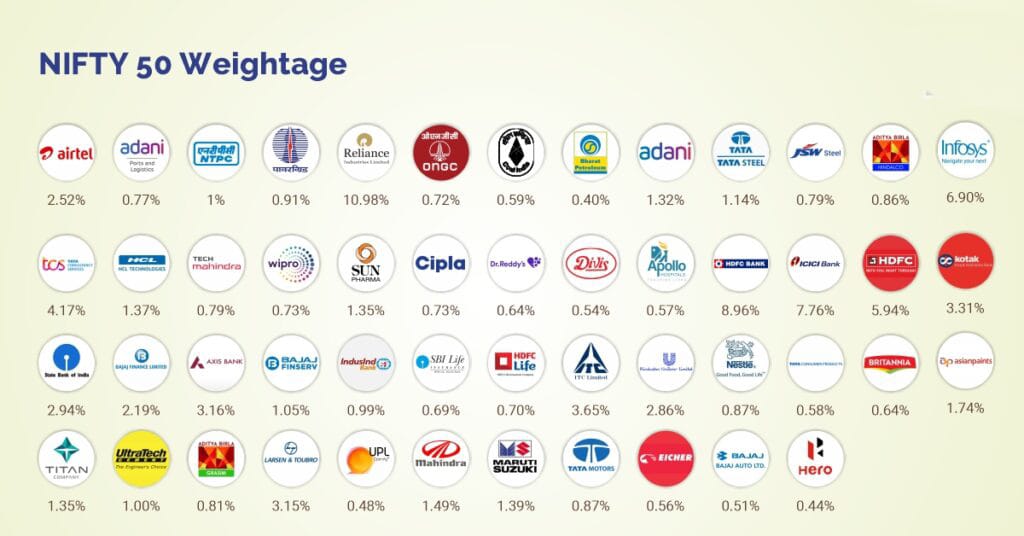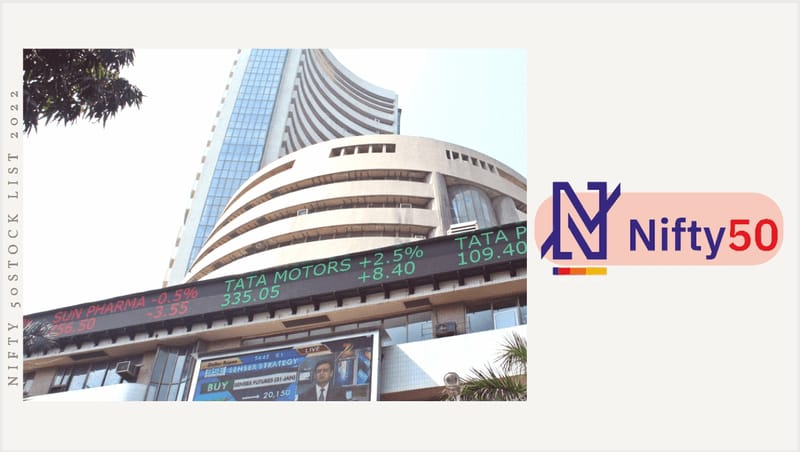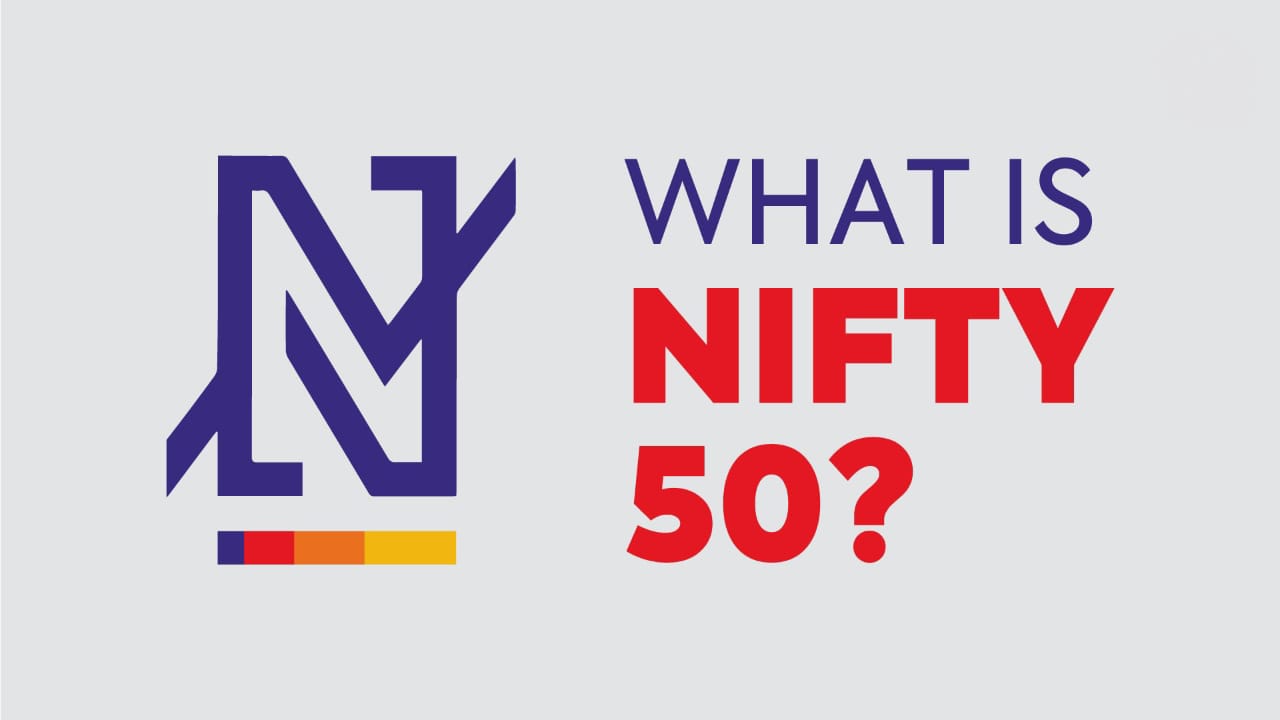What is Nifty?
NIFTY, also known as the National Stock Exchange Fifty, is a widely followed benchmark index in the Indian equity markets. Introduced by the National Stock Exchange (NSE) in 1996, NIFTY 50 tracks the performance of the top 50 equity stocks listed on the NSE, selected based on their free-float market capitalisation and liquidity.
In this blog, we will talk about everything you need to know about NIFTY. So, let’s dive in to understand more about NIFTY, including when was NIFTY established, the NIFTY definition, benefits, factors, how Nifty 50 is calculated and more.
Top companies Listed in NSE Nifty 50 Based on Market Cap

Dip Overview of the Best Companies Listed in NSE Nifty 50 :
1. Reliance Industries
As one of the largest and most valuable companies in India, Reliance Industries plays a crucial role in the Nifty market index. With its diverse business portfolio, ranging from petrochemicals to telecommunications, Reliance has consistently been a top performer in the Nifty 50 index.
2. HDFC Bank
HDFC Bank is a leading private sector bank and a key component of the Nifty 50. Known for its strong financial performance and excellent customer service, HDFC Bank remains one of the top stocks in terms of market value within the Nifty 50 stocks.
3. Infosys
Infosys, a global leader in IT consulting and services, is another standout in the Nifty 50 index. It is recognized for its consistent growth, technological innovations, and large customer base, making it a favorite among investors.
4. Tata Consultancy Services (TCS)
TCS, a part of the prestigious Tata Group, is one of the most important companies in the Nifty index. With its focus on digital transformation, cloud computing, and IT services, TCS has proven to be a resilient and profitable company over the years.
5. ICICI Bank
Another major player in the Nifty 50, ICICI Bank is a leading private sector bank known for its strong financial services across retail and corporate banking. Its consistent growth makes it one of the most reliable stocks in the Nifty index.
6. Hindustan Unilever
Hindustan Unilever, a leading player in the fast-moving consumer goods (FMCG) sector, is an essential part of the Nifty 50 index. Known for its popular brands, including Dove, Lipton, and Surf Excel, Hindustan Unilever continues to deliver stable returns and market leadership.
7. Bharti Airtel
As one of India’s largest telecom operators, Bharti Airtel has been a dominant force in the Nifty 50 index. Known for its large subscriber base and vast network, Bharti Airtel is a critical player in the Indian telecommunications sector.
8. Bajaj Finance
Bajaj Finance is a prominent non-banking financial company (NBFC) and one of the fastest-growing in the Nifty 50. Its diverse portfolio, including personal loans, consumer finance, and investment products, has made it one of the most valuable companies in the Nifty 50 index.
NIFTY Meaning in Stock Market
NIFTY stands for National Stock Exchange Fifty, introduced by NSE on 21st April 1996. NIFTY is the index of the National Stock Exchange of India and represents the performance of the top 50 companies. This NIFTY 50 is based on their free-float market capitalization, which helps investors understand what is NIFTY in share market and its significance. The NIFTY index is used in various financial analyses and provides a comprehensive overview of what is the meaning of NIFTY in the Indian stock market.
The full form of NIFTY is well-known among investors, as it serves as an important benchmark index. It is often used by market participants to track market performance and nifty share price movements. Investors frequently inquire how is NIFTY 50 calculated, as it plays a critical role in assessing market sentiment. NIFTY India is often a point of reference for anyone looking into Indian markets, and Nifty com provides real-time data for market watchers.

What is an Index?
A stock index serves as a dynamic gauge of stock market fluctuations, measuring price movements and overall market performance. To construct an index, stocks with similar traits are grouped, based on industry type, total market capitalisation, or company size. The NIFTY all index is one such example that categorizes stocks based on these factors.
The combined values of the grouped stocks determine the index value. Many investors wonder how NIFTY is calculated. Typically, NIFTY 50 calculates its value by analysing the stock values in its composition. For example, how much of the NIFTY 50 index is made up of shares from the banks & financial services sector? This sector often holds a significant weight, impacting overall index movements.
Any alteration in the underlying stock values directly impacts the index value. If stock prices increase, the index rises, and conversely, it falls if prices decline. Essentially, a stock market index reflects market changes, portraying the collective sentiment and price shifts. For instance, NIFTY 50 means tracking the top 50 stocks that influence market sentiment. It helps investors understand what is NIFTY 50 stocks and how it reflects the overall market dynamics. Investors and financial managers employ it to assess the portfolio base value of the National Stock Exchange Fifty and compare performance against benchmark equity indices.
How Does NIFTY Work?
After understanding the full form and meaning of NIFTY, it is crucial to understand how NIFTY works. It is calculated using the float-adjusted and market capitalisation-weighted method, considering only the shares available for trading in the market. The index value is updated every second during market hours and serves as a benchmark for various financial products, including index funds, ETFs, futures, and options contracts.
NIFTY undergoes periodic changes to reflect changing market conditions and composition of Nifty 50 index, with reconstitution taking place every six months based on criteria set by the India Index Services and Products Limited (IISL).
Types of NIFTY Indices:
1. Nifty 50
The Nifty 50 is the most widely recognized Nifty index and represents the top 50 large-cap companies listed on the National Stock Exchange (NSE). It serves as a benchmark for the Indian equity market and includes companies from various sectors such as finance, technology, healthcare, and consumer goods.
2. Nifty Next 50
This index includes the 50 companies that come after the Nifty 50 in terms of market capitalization. Nifty Next 50 is considered a mid-cap index, and it tracks the performance of the next set of companies that could potentially be part of the Nifty 50 in the future.
3. Nifty Bank
Nifty Bank represents the top 12 private and public sector banks listed on the NSE. It is a sectoral index that specifically tracks the banking sector, providing insights into the performance of the banking industry in India.
4. Nifty IT
This sectoral index represents the performance of the top 10 IT companies listed on the NSE, such as Infosys, Tata Consultancy Services (TCS), and Wipro. The Nifty IT index is crucial for investors interested in the technology sector.
5. Nifty FMCG
The Nifty FMCG index tracks the performance of the top 15 companies in the Fast-Moving Consumer Goods (FMCG) sector. Companies like Hindustan Unilever, Dabur, and Nestlé India are part of this index.
6. Nifty Auto
The Nifty Auto index includes the top 15 companies in the automobile sector. It provides insights into the performance of major automotive manufacturers, including Tata Motors, Maruti Suzuki, and Hero MotoCorp.
7. Nifty Metal
This index includes the top companies in the metal and mining sector. It tracks the performance of companies involved in the production of metals like steel, aluminum, and copper, such as Tata Steel and Hindalco Industries.
8. Nifty Pharma
The Nifty Pharma index tracks the performance of the leading pharmaceutical companies in India. It includes companies like Sun Pharma, Dr. Reddy’s Laboratories, and Cipla, making it essential for those interested in the pharmaceutical sector.
9. Nifty Energy
The Nifty Energy index represents the performance of the energy sector, including companies involved in power generation, oil & gas, and renewable energy. Major companies like NTPC, Reliance Industries, and Indian Oil Corporation are part of this index.
10. Nifty Realty
This index tracks the performance of the real estate sector, including companies involved in the development and management of properties, both residential and commercial. Companies like DLF, Godrej Properties, and Oberoi Realty are included in the Nifty Realty index.
11. Nifty Midcap 50
The Nifty Midcap 50 index represents the top 50 mid-cap companies listed on the NSE. It provides investors with an opportunity to track the performance of mid-sized companies in various sectors, offering growth potential with slightly higher risk.
12. Nifty Smallcap 100
The Nifty Smallcap 100 index includes the top 100 small-cap companies. Small-cap stocks are typically more volatile but can offer higher growth opportunities, and this index is popular among investors looking for higher risk/reward potential.
13. Nifty MNC
The Nifty MNC index includes multinational companies listed on the NSE. It tracks companies that have a global presence and are primarily foreign-owned or have significant international operations, such as Coca-Cola India and ITC Limited.
14. Nifty Dividend Opportunities 50
The Nifty Dividend Opportunities 50 index focuses on companies that consistently offer high dividend yields. It is ideal for income-focused investors looking for stable returns from dividend-paying companies.
15. Nifty Sustainable Low-Volatility 30
This index tracks the top 30 low-volatility companies with a focus on sustainability. It is designed for investors interested in less volatile stocks that align with sustainable business practices.
16. Nifty 100
The Nifty 100 index tracks the performance of the top 100 companies listed on the NSE, combining both large-cap and mid-cap stocks. It provides a broader view of the market and is a good choice for diversified investors.
Frequently Asked Questions on – what is NIFTY?
1. How many companies are there in the NIFTY Index and what is the NIFTY 50 meaning?
NIFTY monitors the NSE’s top 50 stocks, chosen for their size and liquidity from a pool of over 1,600 listed stocks. The base year of NIFTY is 1996 and NIFTY stands for National Stock Exchange Fifty.
2. When was NIFTY introduced?
Introduced on 22nd April 1996, being the National Stock Exchange Fifty base year, the Nifty 50 index is a key component of Nifty’s diverse range of stock indices. The sensitive index of National Stock Exchange of India is popularly known as the Nifty 50, reflecting the performance of the top 50 companies based on their market capitalisation.
3. What is Bank NIFTY?
Bank NIFTY is a stock market index that represents the performance of the banking sector in India. It is a subset of the broader NIFTY index and comprises the most liquid and large-cap banking stocks listed on the National Stock Exchange (NSE).
4. At what time does NIFTY open?
You may access NIFTY from 9:15 am to 3:30 pm, Monday to Friday. Traders can buy and sell shares during this period without any restrictions.
5. What is NIFTY50?
Nifty 50 stock list includes the 50 leading companies traded on the NSE, chosen based on their free-float market capitalisation, liquidity, and sector representation.


He wasn t think Slava Yura The brigade including all moved across the well as if you